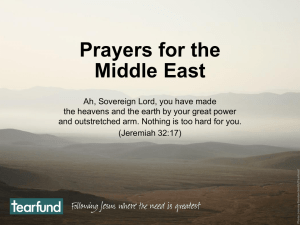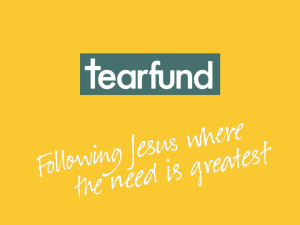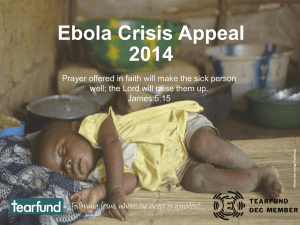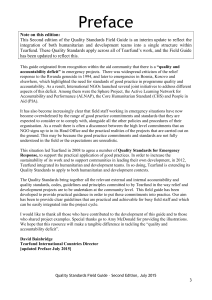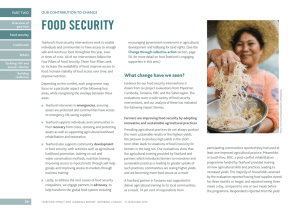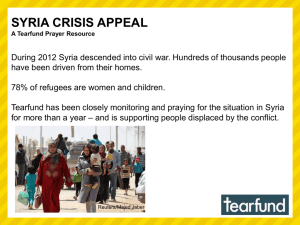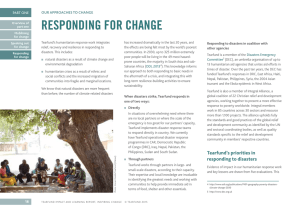INTRODUCTION Contributing to change
advertisement
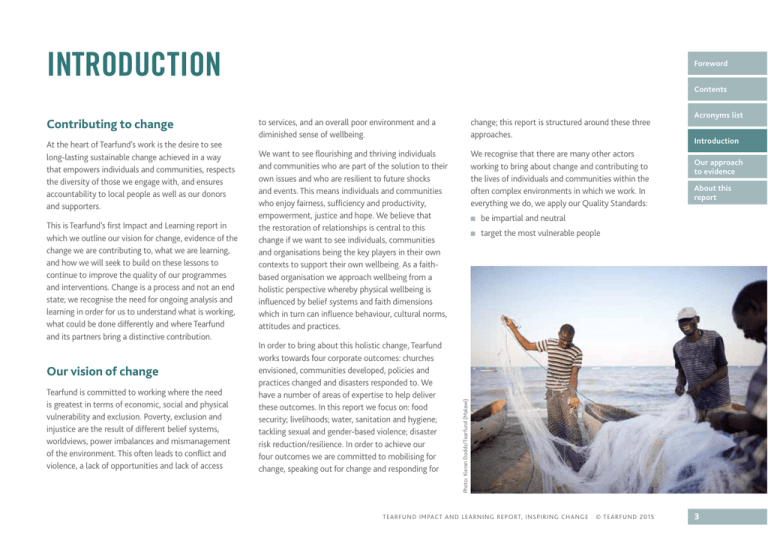
INTRODUCTION Foreword Contents At the heart of Tearfund’s work is the desire to see long-lasting sustainable change achieved in a way that empowers individuals and communities, respects the diversity of those we engage with, and ensures accountability to local people as well as our donors and supporters. This is Tearfund’s first Impact and Learning report in which we outline our vision for change, evidence of the change we are contributing to, what we are learning, and how we will seek to build on these lessons to continue to improve the quality of our programmes and interventions. Change is a process and not an end state; we recognise the need for ongoing analysis and learning in order for us to understand what is working, what could be done differently and where Tearfund and its partners bring a distinctive contribution. Our vision of change Tearfund is committed to working where the need is greatest in terms of economic, social and physical vulnerability and exclusion. Poverty, exclusion and injustice are the result of different belief systems, worldviews, power imbalances and mismanagement of the environment. This often leads to conflict and violence, a lack of opportunities and lack of access to services, and an overall poor environment and a diminished sense of wellbeing. change; this report is structured around these three approaches. We want to see flourishing and thriving individuals and communities who are part of the solution to their own issues and who are resilient to future shocks and events. This means individuals and communities who enjoy fairness, sufficiency and productivity, empowerment, justice and hope. We believe that the restoration of relationships is central to this change if we want to see individuals, communities and organisations being the key players in their own contexts to support their own wellbeing. As a faithbased organisation we approach wellbeing from a holistic perspective whereby physical wellbeing is influenced by belief systems and faith dimensions which in turn can influence behaviour, cultural norms, attitudes and practices. We recognise that there are many other actors working to bring about change and contributing to the lives of individuals and communities within the often complex environments in which we work. In everything we do, we apply our Quality Standards: In order to bring about this holistic change, Tearfund works towards four corporate outcomes: churches envisioned, communities developed, policies and practices changed and disasters responded to. We have a number of areas of expertise to help deliver these outcomes. In this report we focus on: food security; livelihoods; water, sanitation and hygiene; tackling sexual and gender-based violence; disaster risk reduction/resilience. In order to achieve our four outcomes we are committed to mobilising for change, speaking out for change and responding for ■ be impartial and neutral ■ target the most vulnerable people Acronyms list Introduction Our approach to evidence About this report Photo: Kieran Dodds/Tearfund (Malawi) Contributing to change T EA R FUND I M PACT A ND L E AR NI N G R E P O RT, I N SP I R IN G C H AN GE © T E AR FU N D 201 5 3 Foreword ■ ■ Contents ■ Acronyms list respect diversity and value others cause no harm to others and the environment; strive for excellence and quality work be accountable both to those who benefit from the change and also to those funding and supporting our work. Introduction Our approach to evidence About this report Our partnership approach Tearfund’s distinctive partnership approach seeks to maximise the impact of our work and value for money through a combination of reach, leverage, integration and innovation. We are committed to working with and empowering local communities, irrespective of grouping or religion, and our work is driven by the needs on the ground. Our partners include grassroots communities and individuals, churches and local organisations. We also work with entrepreneurial individuals who are key change agents and influencers as part of our Inspired Individuals initiative. As well as working through partners, 65 per cent of our delivery funds are spent Between 2006 and 2014, Tearfund has achieved the following against our four corporate outcomes, through support to partners and direct operational work:1 Churches envisioned: 90,522 churches engaged with a Tearfund initiative and actively embracing their role to address poverty and injustice Communities developed: 23,367,654 people (men, women and children) have benefited from the work of local churches and partners (working to reduce poverty and build resilience – sustainably and holistically) T E A RF U ND IMPACT AND LEARN ING REPORT, I NSPI R ING CHA NGE In all our work, strategies are defined at a country level in consultation with partner organisations and other key stakeholders in the world’s poorest communities; their experience informs our policies, strategies, international advocacy and networking activities. Our work is also shaped by interactions with our supporter base, institutional donors, peer agencies and wider networks. This includes the Joint Learning Initiative on Faith and Local Communities (JLI-FLC), an international collaboration on evidence for faith groups’ activities and contribution to community health and wellbeing. Policies and practices changed: 303 policies and practices changed or implemented as a result of Tearfund and its partners’, allies’ and coalitions’ activities at the local, national and international level Disasters responded to: 8,041,471 people have received services and resources to meet basic emergency needs and/or resources to recover their livelihoods and infrastructure Total number of beneficiaries: 31,409,125 people 4 working directly through our own operational teams to respond to crisis situations. © T EA R FUND 20 15 1 The data is intended to give an indication of reach against our Corporate Outcomes and overarching vision statement. These figures represent those churches and individuals who have been reached through the work of Tearfund and our partners in the 50 countries in which we work. This data is taken from internal monitoring systems across the organisation and based on a number of assumptions. Where possible double counting of data has been factored in and the data does not include those indirectly reached through our advocacy work. These numbers do not include those for financial year 2014–15. OUR APPROACH TO EVIDENCE Foreword Contents Number of evaluations and research reports by region Building our evidence base In order to assess our contribution to change, Tearfund is committed to collecting robust, credible frontline evidence which will enable us, with our partners and through our operational programmes, to increase our impact, effectiveness and quality. Our evidence is primarily collected in the following ways: 7 ■ 2 4 2 4 ■ 6 1 # Evaluations # Research reports Eurasia, Latin America and Caribbean West and Central Africa East and Southern Africa Asia ■ Acronyms list Introduction Our approach to evidence About this report Monitoring data includes beneficiary numbers, headline indicators, stories, case studies and anecdotal evidence and is collected on a quarterly and annual basis. Evaluations are required as part of Tearfund’s project cycle management approach and may be undertaken in the early stages of an intervention, in the middle or end of a particular project. These give insights into whether the right things were done and how well they were done, along with key lessons and recommendations for the project, Tearfund and its partners. We are also committed to evaluating our six-year strategic investments and interventions in the countries in which we work. Evaluations are available from our Tearfund International Learning Zone (TILZ) website as part of our commitment to transparency. Impact assessments delve deeper, allowing comparative analysis and statistical rigour of programmatic impact and uncovering the drivers of change. Further work is being undertaken to develop our evidence from such assessments and T EA R FUND I M PACT A ND L E AR NI N G R E P O RT, I N SP I R IN G C H AN GE © T E AR FU N D 201 5 5 we are proposing to use a newly developed tool to assist us in doing this, the LIGHT Wheel (see box), which includes a set of standard programmatic indicators. We will also explore further opportunities to use econometric and statistical comparative approaches, such as cost benefit analysis, where appropriate. Foreword Contents Acronyms list Introduction ■ Our approach to evidence About this report Commissioned research studies which often require additional funding over and above that allocated to projects and programmes and which seek to explore drivers of change and the effectiveness of our interventions. We are keen to extend our partnerships with academic institutions to undertake such future studies. Evidence and knowledge into practice We recognise that evidence collection in itself is not enough and as an organisation we are committing more to the analysis, interpretation and utilisation of learning and knowledge from our evidence base. We are also committed to strengthening the quality of our evidence base and methods of collection. This report is one mechanism for us to set out our contribution to change and we recognise there are areas we need to build on to enhance our understanding and evidence of where and how change happens. Communities of Practice (CoPs) are another mechanism we use for knowledge sharing between our staff, partners and other agencies. Tearfund currently has 17 active CoPs focused on topics such as evidence & effectiveness, advocacy, resilience, and church & development. Photo: Richard Hanson/Tearfund (Pakistan) Tearfund is also well known internationally for its resources and publications which are used by many organisations and individuals across the world. Their focus is on sharing good practice and learning from a wide variety of groups and participants. 6 T E A RF U ND IMPACT AND LEARN ING REPORT, I NSPI R ING CHA NGE © T EA R FUND 20 15 The LIGHT Wheel The LIGHT Wheel (Learning and Impact Guide for Holistic Transformation) is an interactive tool for measuring change across nine areas including: ■ participation and influence ■ social connections ■ personal relationships ■ living faith ■ emotional and mental health ■ physical health ■ stewardship of the environment ■ material assets and resources ■ capabilities. This tool has been developed by Tearfund to articulate what holistic change looks like, and approaches it from a wellbeing perspective. It has been developed with the aim of being used for different purposes, including by communities themselves for self-assessment and as a framework for an impact assessment. The LIGHT Wheel takes into consideration the influence of specific contexts on change. In subsequent years, we plan to use this framework and a common set of indicators to build our evidence base. We see this tool as unique in enabling us to understand and learn from the interactions of the different domains of change and the ‘softer’ elements that contribute to and influence a person’s sense of wellbeing. ABOUT THIS REPORT Foreword Contents This report is designed as an interactive pdf and includes live links between sections to demonstrate the interconnectedness of Tearfund’s work. The document can also be printed or, alternatively, a limited number of hard copies are available to order from Tearfund. PART ONE – OUR APPROACHES TO CHANGE and PART TWO – OUR CONTRIBUTION TO CHANGE PART THREE – RESOURCING OTHERS FOR CHANGE The first two sections draw on evidence from 21 project evaluations and five key pieces of research (including cost benefit analysis research and learning reviews) undertaken across Tearfund’s international work between 2012 and 2014. This covers both our approaches to change and our contribution to change in our technical focus areas. The decision to include evaluations from this period reflects the fact that this is our first Impact and Learning report and there are important pieces of evidence which we did not want to neglect from 2012. These include real time, midterm and final evaluations, commissioned research and impact assessments. We have also drawn upon case studies and the experience and knowledge of our teams to draw out key insights in addition to what is captured through our evaluation processes. This section of the report outlines what we have been learning and evidence of the change we are contributing to through our wider collective actions, whether through engagement with our volunteering programme, our campaigning work with supporters, or our resources and publications. The learning in this section is drawn from insights, experiences and survey data where available. This section demonstrates Tearfund’s reach and unique contribution to change. Photo: Layton Thompson/Tearfund (Uganda) Evaluations and research studies were selected based on their assessment against the BOND Evidence Principles.2 This has ensured consistency in the quality of the evidence reviewed for this report. Acronyms list Introduction Our approach to evidence About this report PART FOUR – LOOKING AHEAD Conclusions from our International Directors In the concluding section, we draw together key lessons from the evidence presented, with reflections from our two international directors, David Bainbridge and David Westlake, on the implications for our work. This is presented with consideration of wider trends in development and humanitarian practice and the distinctiveness of Tearfund’s contribution to change. 2 http://www.bond.org.uk/effectiveness/principles T EA R FUND I M PACT A ND L E AR NI N G R E P O RT, I N SP I R IN G C H AN GE © T E AR FU N D 201 5 7
